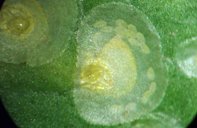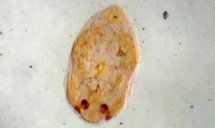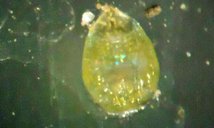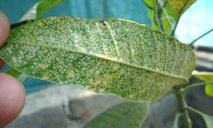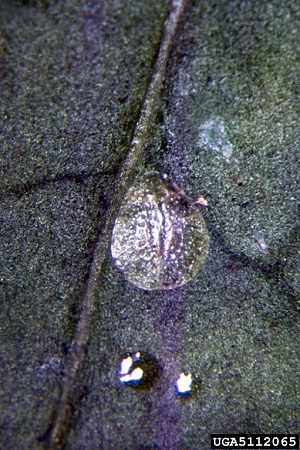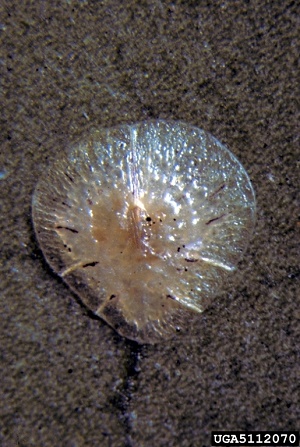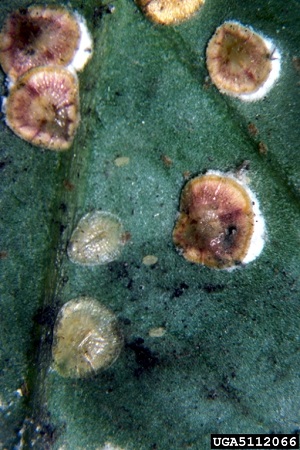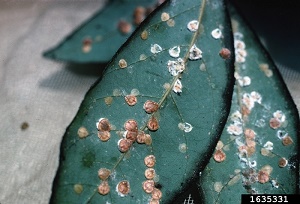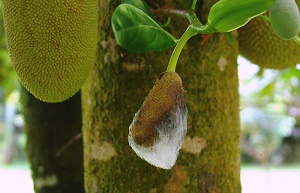| Jackfruit Pests and Diseases | ||||||||||||||||||||||||
|---|---|---|---|---|---|---|---|---|---|---|---|---|---|---|---|---|---|---|---|---|---|---|---|---|
| Back
to Jackfruit Page  Fig. 1  Coconut scale, Aspidiotus destructor Signoret, showing eggs, nymphs and exuviae, and adult female with cover removed  Fig. 7  Pyriform Scale Protopulvinaria pyrifomis Cockerell  Fig. 12  Jackfruit (Artocarpus heterophyllus): Rhizopus rot
| Pests There are a number of wood boring insects that may attack wounded or dead wood along the trunks and branches (Elaphidion mucronatum, Nyssodrysina haldemani, Leptostylopsis terraecolor). Various scales such as the lesser snow scale (Pinnaspis strachani), coconut scale (Aspidiotus destructor), mango shield scale (Protopulvinaria mangiferae), pyriform scale (Protopulvinaria pyrifomis) and mealybugs may attack stems and fruit. Please contact your local Agricultural Extension Agent for current control options. 1 Coconut Scale Aspidiotus destructor Signoret Coconut scale resembles other armored scales in that the body is protected by a waxy cover. Infestations may be noted by the formation of closely packed colonies composed of what resemble miniature fried eggs. Females develop through two nymphal stages, while males have an additional non-feeding pre-pupal stage (four immature stages). Removal of sap from leaves, petioles, peduncles and fruits leads to discoloration, depressions, and tissue distortions on leaves. Coconut scales may possibly introduce toxins into the plant through their saliva (Waterhouse and Norris, 1987). 2 Pruning and training of fruit trees and proper disposal of infested leaves, branches and twigs will help control scale insects on nursery plants and trees. Excessive use of plant fertilizers contributes to scale outbreaks. Various insecticides are registered for control of armored scales in ornamental and fruit crops. 2
Fig. 2. Adult female coconut scale, A. destructor Signoret, showing eggs under cover Fig. 3. Coconut scale, male pupa removed from cover Fig. 4. Adult female removed from cover Fig. 5. Adult male Fig. 6. Underside of mango leaf infested with coconut scale Further Reading Coconut Scale Aspidiotus destructor Signoret, University of Florida pdf Coconut Scale (Aspidiotus destructor Signoret), University of Guam, ADAP project pdf Pyriform Scale Protopulvinaria pyrifomis Cockerell If your plants have a black-looking, sooty appearance, flip the leaves over and look for scale pests, such as the pyriform scale. This soft scale species excretes large quantities of ingested plant sap. This bug waste has a more socially acceptable name of ”honeydew” amongst plant people. The honeydew is rich in plant sugars that the scale insect doesn’t utilize. When the honeydew accumulates on the foliage, an opportunistic fungus soon colonizes what the scale insect squirts out. Damage can result in poor vigor and eventually, defoliation. There are repeating generations of this sucking pest during the year, so careful monitoring of plants is required to avoid scale population build-up. For immediate results either pluck infested leaves or if a heavy infestation is active use a pesticide. Try a 2% horticultural (paraffinic mineral) oil solution when the smaller stages are present. Spray the undersides of the leaves thoroughly. Repeat at monthly intervals until pest is gone. 3
Fig. 8. Pyriform scale nymphs Fig. 9. Pyriform scale adult Fig. 10. Pyriform scale multiple life cycles Fig. 11. Pyriform scale P. pyrifomis mature dead females Further Reading Pyriform Scale (Protopulvinaria pyriformis), University of Florida, Collier County pdf Lesser Snow Scale Pinnaspis strachani Further Reading Lesser know scale Pinnaspis strachani, California Department of Food and Agriculture pdf (archived) Diseases In general, jackfruit have few disease problems in south Florida. Male flowers and fruit may be attacked by Rhizopus fruit rot (Rhizopus artocarpi) and fruit by gray mold (Botrytis cinerea). Trees are susceptible to root rot (Pythium splendens, Phytophthora sp., Fusarium sp., Rhizoctonia sp.) especially when subjected to flooding. Several fungi (i.e., Gloeosporium sp., Phyllosticta artocarpi) cause leaf spotting. Please contact your local Agricultural Extension Agent for current control options. 1 Rhizopus Fruit Rot Rhizopus artocarpi Rhizopus rot is a common fungal disease of jackfruit flowers and fruit. Rot is more likely to occur in high-rainfall areas or during and after stormy periods. When warm, humid, wet weather coincides with the flowering and fruiting season, rhizopus rot can cause total loss of fruit in jackfruit trees. At first, soft, watery, brown spots develop on the flowers and fruit. Subsequently, a powdery, fuzzy-looking mass of black spores and white fungal mycelia covers the jackfruit surface. The pathogen engulfs the young fruit, resulting in the characteristic black, rotten, shrunken, and sometimes mummified fruit remains. Fruit symptoms can appear on the tree or can develop on fruit that are in storage or transit. Three species of plant-pathogenic fungi of the genus Rhizopus can cause this disease in the tropics: Rhizopus oryzae, Rhizopus artocarpi, and Rhizopus stolonifer. No jackfruit varieties are reported to have significant resistance to the disease. 4
Fig. 14. Rhizopus soft rots (Rhizopus sp.) on jackfruit Further Reading Rhizopus Rot of Jackfruit, University of Hawai'i at Mānoa pdf Further Reading Jackfruit Growing in the Florida Home Landscape, University of Florida pdf | |||||||||||||||||||||||
| Bibliography 1 Crane, Jonathan H., et al. "Jackfruit Growing in the Florida Home Landscape." Horticultural Sciences Dept., UF/IFAS Extension, HS-882, Pub. date May 2002, Revised Oct. 2005 and Nov. 2016, Reviewed Dec. 2019, AskIFAS, edis.ifas.ufl.edu/mg170. Accessed 17 Jan. 2017, 6 July 2020. 2 Salahud din, and Steven P. Arthurs. "Coconut Scale Aspidiotus destructor Signoret (Insecta: Hemiptera: Diaspididae)." Entomology and Nematology Dept., UF/IFAS Extension, EENY622, Original pub. Mar. 2015, Mar. 2015. Revised May 2021, AskIFAS, edis.ifas.ufl.edu/IN1084. Accessed 16 Nov. 2015, 2 Nov. 2019, 15 Jan. 2022. 3 Caldwell, Doug. "Pyriform scale (Protopulvinaria pyriformis)." University of Florida, Collier County Extension, edis.ifas.ufl.edu. Accessed 23 Jan. 2017. 4 Nelson, Scot. "Rhizopus Rot of Jackfruit." University of Hawai‘i at Mänoa, Cooperative Extension Service, Honolulu, Hawai‘i. July 2005, CTAHR, ctahr.hawaii.edu. Accessed 22 Dec. 2014. Photographs Fig. 1 Salahud din. "Coconut scale, Aspidiotus destructor Signoret, showing eggs, nymphs and exuviae, and adult female with cover removed." UF/IFAS Extension, AskIFAS, edis.ifas.ufl.edu. Accessed 23 Jan. 2017. Fig. 2 Salahud din. "Adult female coconut scale, Aspidiotus destructor Signoret, showing eggs under cover." UF/IFAS Extension, AskIFAS, edis.ifas.ufl.edu. Accessed 23 Jan. 2017. Fig. 3 Salahud din. "Coconut scale, Aspidiotus destructor Signoret, male pupa removed from cover." UF/IFAS Extension, AskIFAS, edis.ifas.ufl.edu. Accessed 23 Jan. 2017. Fig. 4 Salahud din. "Adult female coconut scale, Aspidiotus destructor Signoret, removed from cover." UF/IFAS Extension, AskIFAS, edis.ifas.ufl.edu. Accessed 23 Jan. 2017. Fig. 5 Salahud din. "Adult male coconut scale, Aspidiotus destructor Signoret." UF/IFAS Extension, AskIFAS, edis.ifas.ufl.edu. Accessed 23 Jan. 2017. Fig. 6 Salahud din. "Underside of mango leaf infested with coconut scale, Aspidiotus destructor Signoret." UF/IFAS Extension, AskIFAS, edis.ifas.ufl.edu. Accessed 23 Jan. 2017. Fig. 7,8,9,10 "Pyriform Scale Protopulvinaria pyrifomis." United States National Collection of Scale Insects Photographs Archive, USDA Agricultural Research Service, 2006, Updated 2011, Bugwood.org, (CC BY-NC 3.0 US), bugwood.org. Accessed 21 Dec. 2014. Fig. 11 Davidson, J. A. "Pyriform Scale Protopulvinaria pyrifomis. Mature dead females." United States National Collection of Scale Insects Photographs Archive, USDA Agricultural Research Service, 1975, Updated 2011, Bugwood.org, (CC BY-NC 3.0 US), bugwood.org. Accessed 23 Jan. 2017. Fig. 12,13 Nelson, Scot C. "Rotting Fruits Covered with Mycelium, Rhizopus rot (fungus, Rhizopus spp.)." University of Hawai'i at Mānoa, 2005, Hawai'i Plant Diseases, (CC BY 2.0), hawaiiplantdisease.net. Accessed 20 Jan. 2014. Fig. 14 Seethapathy, Parthasarathy. "Rhizopus soft rots (Rhizopus sp.) Ehrenb. on jackfruit (Artocarpus heterophyllus Lam.)." 2016, Bugwood.org, (CC BY-NC 3.0 US), bugwood.org. Accessed 24 Jan. 2017. Published 12 Apr. 2014 LR. Last update 15 Jan. 2022 LR | ||||||||||||||||||||||||
